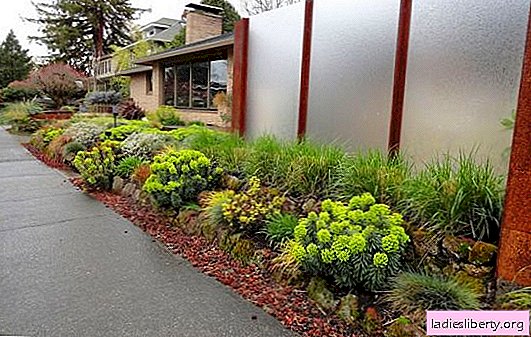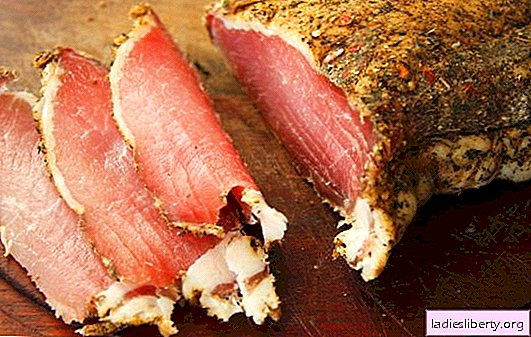
On any plot there is at least one problem zone. Attempts to grow plants there turn out to be a failure for many - they all quickly fade and dry out. Do not despair if you are unable to green such places. Similar problems are easily solved.
NARROW PASSAGE
Before you start planting plants, make sure that there is enough room for easy access. Lay the paving stones on the path or sprinkle small pebbles: pebbles or gravel. This will help suppress weed growth.
If the road passes near the fence, decorate it with plants in baskets, this will add color and texture.
On wider aisles, you can plant dwarf varieties of trees, shrubs and climbing plants.
What to plant
Thyme or Golden Oregano Feel great under the scorching sun, and the Succulents and Dichondra "Silver Falls" in the shade.
Dianella "Tiny Titan"can grow both in the sun and in the shade, and the bugle "Ayuga", ferns and ivy in constantly darkened areas of the garden.
From tall plants fit camellia bushes - they grow well in the shade or magnolia "Little gem" prefers sunny areas.
Apple tree "Ballerinas" and bushes of Nandina will also be able to bloom in such conditions.
BIG SHADOW
Problematic areas often arise under tree crowns or under awnings. In such places there is a large dryness of the soil and they are very shaded. Because of this, the lawn cannot grow on them, but nature does not like emptiness, because soon such sites will be overgrown with weeds.
What to plant
Silver Shield (Plectranthus Silver), with silver leaves and white flowers, likes a shadow and well tolerates the sun's rays, while plektrantuseklona prefers a deeper shadow. Both grow rapidly, but plantings are easy to control.
Liriope and Clivia they will add contrast to such areas, and the goryanka will form a dense beautiful cover of the earth.
Bilbergia, friesia and echmea suitable for growing in cold climates, and succulents for regions with hot.
From tall plants in such conditions they will be able to growEuphorbia or Fatsia Japanese.
HOT WALLS
In hot sunny weather, metal fences and houses, trimmed with sheets of iron, become very hot in direct sunlight. The temperature near them is several times higher than in the shade. Many plants die after a couple of hours near them.
What to plant
Such conditions can withstand oleander, fotinia, pomegranate and fig tree, and olive bushes.
Near them you can plant low plants: bearded irises, stunted grevillea, cordilina and Mediterranean herbs such as rosemary and thyme which will cover like a carpet, and landing petunia and daisies bring color to this corner of the garden.
CLOSE TO HOUSE
You should never allow the soil level near the house to be higher than waterproofing and it is better to leave it not sown with plants. Violation of this rule is the main cause of damp indoors. Leave at least 30 cm of free space. However, they do not always comply with this requirement, for example, in Australia, sown areas are adjacent to houses.
If you also want to refine this area, then you need to pick plants with long leaves and stems that will allow air to circulate freely around.
In order not to breed dampness during watering, you will need to install a drip irrigation system.
What to plant
Exotic plants such as Kangaroo paw, loving the sunny sides of the house, Dianella, preferring shade or graceful shaded agave.
In rich, well-drained soils, you can plant traditional spray roseswhich will saturate during flowering the air in the room near the plantings with their aromas.
Less whimsical can be sown under them. catnip and cleaner.
WET ANGLE
Many gardens have a wet corner. You can fight this by arranging its drainage and increasing the level of the soil layer. Another option is to leave everything as it is and create a grove or a small swamp in this zone, depending on how high the dampness is.
Having planted forest and swamp vegetation in this place, you will create a special corner of nature. Perhaps you even manage to attract frogs to the garden by making a small swamp.
What to plant
Wet and shady places are ideal conditions for organizing an English garden.
Astilbe, hosts, spirea, pratia, primrose, viola and medunica - They look attractive and have their own special charm. After blooming, their flowers do not fall for a very long time and please the eye.
To add height, the landscape will need to be planted ferns. Bright irises it is better to sow in wetlands with established architectural structures. They will add charm to your vacation spot.
PLOT WITH AN INCLINE
Improving a site located on a hill is a difficult task. Even worse, when it rains, water washes the slope, destroying the fertile layer of soil and causing the death of most plants. If the site has a large difference in height, you need to try to enter this lack of site in landscape design. You can make paths with steps carved into the soil and set up a terrace on the slope. Be sure to dig a rainwater drain before this. Still it is worth taking care of the installation of props and barriers from leaching the soil. For planting on areas affected by erosion, pick up unpretentious plants, you can either native species or exotic.
What to plant
Planting trees would be ideal, but it will take years for them to grow. Because at the same time plant fast growing plants, the growth of the root system of which will help strengthen the soil and positively affect the growth of trees.
Herbs and herbaceous plants such as bluegrass, sedge, fescue and agapanthus able to grow rapidly, as well as universally used in landscape design grevillea and star jasmine. Another refinement option is to buy finished lawn in rolls.











